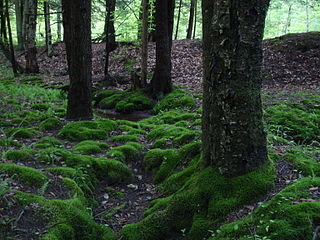
Mosses are small, non-vascular flowerless plants in the taxonomic division Bryophytasensu stricto. Bryophyta may also refer to the parent group bryophytes, which comprise liverworts, mosses, and hornworts. Mosses typically form dense green clumps or mats, often in damp or shady locations. The individual plants are usually composed of simple leaves that are generally only one cell thick, attached to a stem that may be branched or unbranched and has only a limited role in conducting water and nutrients. Although some species have conducting tissues, these are generally poorly developed and structurally different from similar tissue found in vascular plants. Mosses do not have seeds and after fertilisation develop sporophytes with unbranched stalks topped with single capsules containing spores. They are typically 0.2–10 cm (0.1–3.9 in) tall, though some species are much larger. Dawsonia, the tallest moss in the world, can grow to 50 cm (20 in) in height. There are approximately 12,000 species.

Polytrichum commune is a species of moss found in many regions with high humidity and rainfall. The species can be exceptionally tall for a moss with stems often exceeding 30 cm (12 in) though rarely reaching 70 cm (27.5 in), but it is most commonly found at shorter lengths of 5 to 10 cm. It is widely distributed throughout temperate and boreal latitudes in the Northern Hemisphere and also found in Mexico, several Pacific Islands including New Zealand, and also in Australia. It typically grows in bogs, wet heathland and along forest streams.
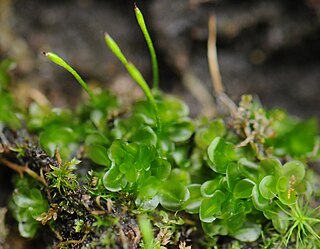
Oedipodium is the only genus of moss in the family Oedipodiaceae. It contains the single species Oedipodium griffithianum, the gouty-moss or Griffith's oedipodium moss. This species is distributed in cooler climates of Eurasia, as well as from Alaska, Washington state, British Columbia, Yukon, Greenland, Newfoundland, Tierra del Fuego and the Falkland Islands.

Tetraphidaceae is a family of mosses. It includes only the two genera Tetraphis and Tetrodontium, each with two species. The defining feature of the family is the 4-toothed peristome.

Hylocomium splendens, commonly known as glittering woodmoss, splendid feather moss, stairstep moss, and mountain fern moss, is a perennial clonal moss with a widespread distribution in Northern Hemisphere boreal forests. It is commonly found in Europe, Russia, Alaska and Canada, where it is often the most abundant moss species. It also grows in the Arctic tundra and further south at higher elevations in, for example, northern California, western Sichuan, East Africa, Australia, New Zealand and the West Indies. In Scotland it is a characteristic species of the Caledonian Forest. Under the UK's national vegetation classification system, pinewood community W18 is named as "Pinus sylvestris-Hylocomium splendens woodland", indicating its significance in this ecosystem.
Tayloria lingulata, commonly known as lingulate dung moss, tongue-leaved gland-moss, or marsh collar-moss, is a moss found in montane habitats in the Northern Hemisphere including Europe, Asia and North America.

Funaria hygrometrica, the bonfire moss or common cord-moss, is a type of water moss which grows on shady, moist soil. It can also be found on moist walls and the crevices of rocks and places where recent fires have taken place. It has been reported to grow in Niagara Cave, an artificially illuminated cave devoid of natural light. Under such conditions, its growth form changes so that the internodes lengthen and the leaves become longer and narrower.

Lycopodiella inundata is a species of club moss known by the common names inundated club moss, marsh clubmoss and northern bog club moss. It has a circumpolar and circumboreal distribution, occurring throughout the northern Northern Hemisphere from the Arctic to montane temperate regions in Eurasia and North America. It grows in wet habitat, such as bogs, ponds, moist spots on the tundra, and long-standing borrow pits.

Polystichum lonchitis is a species of fern known by the common name northern hollyfern, or simply holly-fern. It is native to much of the Northern Hemisphere from Eurasia to Alaska to Greenland and south into mountainous central North America. It has stiff, glossy green, erect fronds and grows in moist, shady, rocky mountain habitats.

Sphagnum palustre, the prairie sphagnum or blunt-leaved bogmoss, is a species of peat moss from the genus Sphagnum, in the family Sphagnaceae. Like other mosses of this type it can soak up water up to the 30-fold amount of its own dry weight thanks to its elastic spiral fibers. S. palustre is rather frequent and is spread almost all over the world. It mainly grows in wet forests and—compared to other specimens of this genus—rarely grows in moors.
Anomobryum julaceum, the slender silver-moss, is a species of bryophyte native to all continents except South America and Antarctica. A. julaceum is found widespread in the temperate regions of the Northern and Southern Hemispheres. Its capsules mature beginning in late fall and through the spring. It is most commonly found in wet crevices and on sandstone cliffs. Additional micro-habitats include tussock tundra with seeps and late snow melt areas and on granitic outcrops. In eastern North America it appears to be restricted to acid habitats, in the wet crevices of sandstone cliffs or other seepy niches. Overall, A. julaceum resembles species of the genus Pohlia, and its leaves are similar to those of Bryum argenteum; it can only be separated from Pohlia and Bryum using a microscope. Anomobryum julaceum can be distinguished from Bryum argenteum by its strongly julaceous, shiny leaves.

Polytrichum juniperinum, commonly known as juniper haircap or juniper polytrichum moss, is an evergreen and perennial species of moss that is widely distributed, growing on every continent including Antarctica.
Tayloria acuminata, commonly known as acuminate dung moss and acuminate trumpet moss, is a bright-green dung moss species with violet radicles that age to a dark red. It is native to North America and Iceland, where it is found in bird cliffs in Hornstrandir. In Iceland it has the conservation status of a vulnerable species (VU).

Fontinalis antipyretica, greater water-moss, or common water moss, is a species of submerged aquatic moss belonging to the subclass Bryidae. It is found in both still and flowing freshwater in Europe, Asia, Greenland and Africa. In North America it is found in most Canadian provinces with a seaboard and most US states except the most southern.
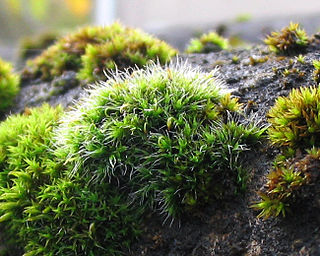
Grimmia pulvinata, otherwise known as grey-cushioned grimmia or pulvinate dry rock moss, is a bryophyte moss common in temperate climates worldwide.
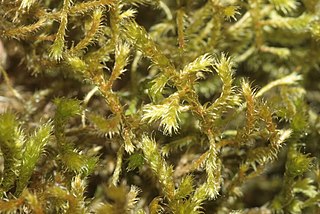
Antitrichia curtipendula is a species of feather-moss found predominantly in western North America and the western coast of Europe.

Plagiomnium cuspidatum, also known as toothed or “baby-tooth” plagiomnium moss and woodsy thyme-moss, is a species of thyme-moss that originated in North America, but can now also be found throughout Middle America, Africa, Northern and Southern Asia, and Europe.

Andreaea nivalis, also known as snow rock-moss, is a species of moss in the Andreaea family found in Alaska, California, Oregon, Washington, Greenland, Spain, Japan, Russia and Poland. It is black and reddish, dioicous, and grows on wet, acidic rocks. It is threatened by droughts and global warming, and is a near-threatened species on the IUCN red list.
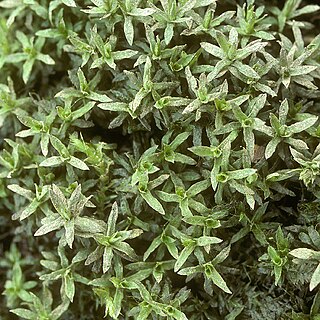
Timmia megapolitana, also known as Indian feather moss and warrior moss is a genus of moss in the family Timmiaceae and order Timmiales.















